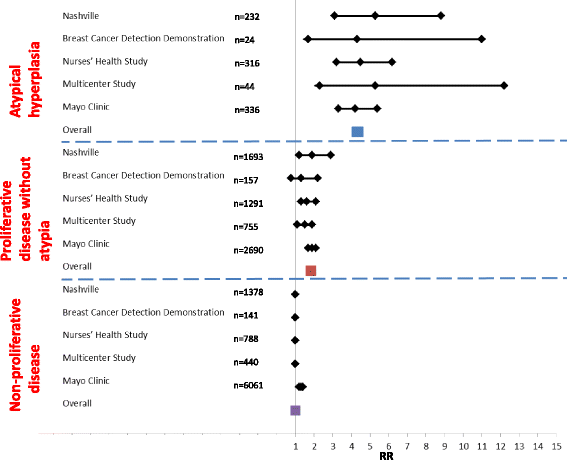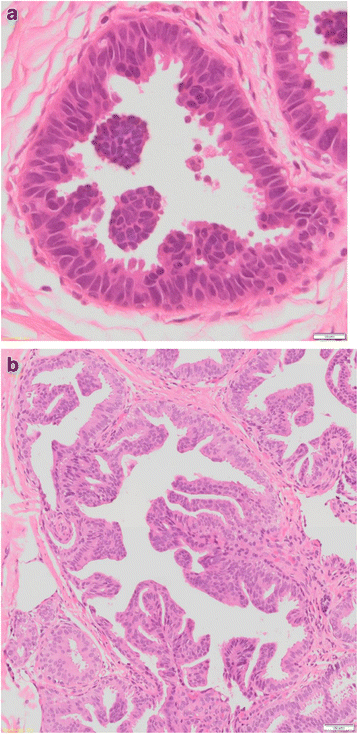Atypical ductal hyperplasia: update on diagnosis, management, and molecular landscape
- PMID: 29720211
- PMCID: PMC5932853
- DOI: 10.1186/s13058-018-0967-1
Atypical ductal hyperplasia: update on diagnosis, management, and molecular landscape
Abstract
Background: Atypical ductal hyperplasia (ADH) is a common diagnosis in the mammographic era and a significant clinical problem with wide variation in diagnosis and treatment. After a diagnosis of ADH on biopsy a proportion are upgraded to carcinoma upon excision; however, the remainder of patients are overtreated. While ADH is considered a non-obligate precursor of invasive carcinoma, the molecular taxonomy remains unknown.
Main text: Although a few studies have revealed some of the key genomic characteristics of ADH, a clear understanding of the molecular changes associated with breast cancer progression has been limited by inadequately powered studies and low resolution methodology. Complicating factors such as family history, and whether the ADH present in a biopsy is an isolated lesion or part of a greater neoplastic process beyond the limited biopsy material, make accurate interpretation of genomic features and their impact on progression to malignancy a challenging task. This article will review the definitions and variable management of the patients diagnosed with ADH as well as the current knowledge of the molecular landscape of ADH and its clonal relationship with ductal carcinoma in situ and invasive carcinoma.
Conclusions: Molecular data of ADH remain sparse. Large prospective cohorts of pure ADH with clinical follow-up need to be evaluated at DNA, RNA, and protein levels in order to develop biomarkers of progression to carcinoma to guide management decisions.
Keywords: Atypical ductal hyperplasia; Breast cancer progression; Breast neoplasms; Clonal relationship; Ductal carcinoma in situ; Patient care management.
Conflict of interest statement
Competing interests
The authors declare that they have no competing interests.
Publisher’s Note
Springer Nature remains neutral with regard to jurisdictional claims in published maps and institutional affiliations.
Figures
Similar articles
-
Factors associated with upgrading to malignancy at surgery of atypical ductal hyperplasia diagnosed on core biopsy.Breast. 2011 Feb;20(1):50-5. doi: 10.1016/j.breast.2010.06.004. Epub 2010 Jul 8. Breast. 2011. PMID: 20619647
-
The diagnosis and management of pre-invasive breast disease: ductal carcinoma in situ (DCIS) and atypical ductal hyperplasia (ADH)--current definitions and classification.Breast Cancer Res. 2003;5(5):254-7. doi: 10.1186/bcr623. Epub 2003 Jul 29. Breast Cancer Res. 2003. PMID: 12927035 Free PMC article. Review.
-
Evidence of chromosomal alterations in pure usual ductal hyperplasia as a breast carcinoma precursor.Oncol Rep. 2008 Jun;19(6):1469-75. Oncol Rep. 2008. PMID: 18497952
-
Atypical ductal hyperplasia is a multipotent precursor of breast carcinoma.J Pathol. 2019 Jul;248(3):326-338. doi: 10.1002/path.5262. Epub 2019 Apr 22. J Pathol. 2019. PMID: 30843206
-
Factors affecting the under-diagnosis of atypical ductal hyperplasia diagnosed by core needle biopsies - A 10-year retrospective study and review of the literature.Int J Surg. 2018 Jan;49:27-31. doi: 10.1016/j.ijsu.2017.11.005. Epub 2017 Nov 13. Int J Surg. 2018. PMID: 29146271 Review.
Cited by
-
Tumor microenvironment and immune system preservation in early-stage breast cancer: routes for early recurrence after mastectomy and treatment for lobular and ductal forms of disease.BMC Immunol. 2024 Jan 25;25(1):9. doi: 10.1186/s12865-023-00591-y. BMC Immunol. 2024. Retraction in: BMC Immunol. 2024 Oct 17;25(1):70. doi: 10.1186/s12865-024-00663-7. PMID: 38273260 Free PMC article. Retracted.
-
Contrast-enhanced ultrasound to predict malignant upgrading of atypical ductal hyperplasia.Breast Cancer Res. 2024 Feb 12;26(1):27. doi: 10.1186/s13058-024-01772-2. Breast Cancer Res. 2024. PMID: 38347651 Free PMC article.
-
Diagnosis accuracy of Raman spectroscopy in the diagnosis of breast cancer: a meta-analysis.Anal Bioanal Chem. 2022 Nov;414(27):7911-7922. doi: 10.1007/s00216-022-04326-7. Epub 2022 Sep 23. Anal Bioanal Chem. 2022. PMID: 36138121
-
Is Surgical Excision of Focal Atypical Ductal Hyperplasia Warranted? Experience at a Tertiary Care Center.Ann Surg Oncol. 2023 Jul;30(7):4087-4094. doi: 10.1245/s10434-023-13319-4. Epub 2023 Mar 11. Ann Surg Oncol. 2023. PMID: 36905438 Free PMC article.
-
The Immune Microenvironment of Breast Cancer Progression.Cancers (Basel). 2019 Sep 16;11(9):1375. doi: 10.3390/cancers11091375. Cancers (Basel). 2019. PMID: 31527531 Free PMC article. Review.
References
-
- Dupont WD, Parl FF, Hartmann WH, Brinton LA, Winfield AC, Worrell JA, Schuyler PA, Plummer WD. Breast cancer risk associated with proliferative breast disease and atypical hyperplasia. Cancer. 1993;71(4):1258–1265. doi: 10.1002/1097-0142(19930215)71:4<1258::AID-CNCR2820710415>3.0.CO;2-I. - DOI - PubMed
Publication types
MeSH terms
LinkOut - more resources
Full Text Sources
Other Literature Sources
Medical



